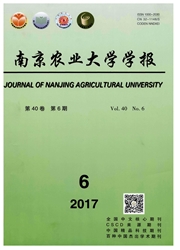

 中文摘要:
中文摘要:
从胜利油田29-8#和29-681#油井附近土壤中筛选到13株石油降解菌,并通过重量法测定其石油降解率,再筛选出3株高效降解菌株DH-5、DH-8和DH-9,其降解率均高于40%。通过形态学观察、生理生化试验和16S rDNA序列分析,发现菌株DH-5、DH-8和DH-9分别属于假单胞菌属(Pseudomonas sp.)、柠檬酸杆菌属(Citrobacter sp.)和克雷伯氏菌属(Klebsiella sp.)。进一步研究3株菌株的底物利用能力,且通过气相色谱法分析了原油代谢产物中的脂肪酸含量,发现以常见石油产品和石油中典型烷烃类和芳香烃类化合物为唯一碳源培养时,菌株DH-5在长链烷烃和环烷烃中生长较好,DH-8在多环芳烃中生长较好,而DH-9在低链烷烃和环烷烃中生长较好,3株高效石油降解菌对原油组分利用的广谱性从大到小依次是DH-5、DH-9和DH-8;分析原油代谢产物发现,发酵液中主要的小分子有机酸是乙酸,菌株DH-5和DH-8的发酵液中还含有C8~C18的长链脂肪酸,菌株DH-9的发酵液中含有C8~C24的长链脂肪酸。上述结果表明:筛选出的高效降解菌株DH-5、DH-8和DH-9代谢原油的方式很可能是单末端氧化和直接脱氢途径。
 英文摘要:
英文摘要:
Thirteen strains of oil-degrading bacteria were isolated from the soil around the 29-8# and 29-681# wells in Shengli oilfield.Of the bacteria,stains DH-5,DH-8 and DH-9 showed higher efficient degradation rates,all above 40%.Then morphological tests,physiological and biochemical experiments,and molecular identifications of 16S rDNA of isolated high efficient oil-degrading bacteria were performed.The three strains were similar to Pseudomonas,Citrobacter and Klebsiella respectively on morphological tests and on physiological and biochemical experiments.Based on the 16S rDNA analyses,strain DH-5 was most close to Pseudomonas geniculata ATCC19374T(AB021404)with 99.707% similarity,strain DH-8 was most close to Citrobacter farmeri CDC2991-81T(AF025371)with 98.818% similarity,and strain DH-9 was most close to Klebsiella oxytoca JCM1665T(AB004754)with 97.700% similarity.Then the three strains′ capacity of utilizing different substrates was studied by using common petroleum products and typical straight-chain alkanes and aromatic hydrocarbons as the sole carbon source,and the composition and content of the fatty acids in metabolites of crude oil were determined by gas chromatography(GC).We then found that strain DH-5 grew well on long-chain alkanes such as liquid paraffin(C16-C20),strain DH-9 grew well on short-chain alkanes such as hexane(C6),and both of the strains could utilize cycloparaffins(such as cyclohexane and cyclohexanone)well.However,strain DH-8 grew poorly or even showed no growth on alkanes,but it showed strong growth on naphthalene and phenanthrene.Strains DH-5 and DH-9 grew poorly on the two pAHs.All the 3 highly oil-degrading bacteria strains could use various components of crude oil,and the capacity of their utilizing hydrocarbons was in the order of DH-5,DH-9,DH-8.The metabolite analysis of the three strains cultured in the oil culture medium showed that acetic acid,propionic acid,butyric acid and valeric acid were all detected in the medium,and acetic acid was the major sho
 同期刊论文项目
同期刊论文项目
 同项目期刊论文
同项目期刊论文
 期刊信息
期刊信息
